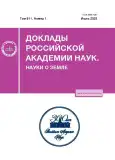MERCURY BACKGROUND IN BOTTOM SEDIMENTS OF THE EASTERN ARCTIC
- Autores: Aksentov K.I.1, Sattarova V.V.1, Astakhov A.S.1, Shi X.2, Ivanov M.V.1, Alatorsev A.V.1, Kim D.V.1
-
Afiliações:
- Il’ichev Pacific Oceanological Institute, Far Eastern Branch of the Russian Academy of Sciences
- First Institute of Oceanography, Ministry of Natural Resources of China
- Edição: Volume 511, Nº 1 (2023)
- Páginas: 93-97
- Seção: OCEANOLOGY
- ##submission.dateSubmitted##: 14.10.2023
- ##submission.datePublished##: 01.07.2023
- URL: https://journals.rcsi.science/2686-7397/article/view/135816
- DOI: https://doi.org/10.31857/S2686739723600443
- EDN: https://elibrary.ru/RYIATO
- ID: 135816
Citar
Texto integral
Resumo
On the basis of dated bottom sediment cores, layers accumulated in the pre-industrial period were selected. They determine the mercury concentrations, which are the geochemical background for the selected water areas. The variability of mercury concentrations in the sediments of the inner shelf is small (20–30 μg/kg) and can be used as a basis for environmental assessment in the economic development of the Arctic regions.
Palavras-chave
Sobre autores
K. Aksentov
Il’ichev Pacific Oceanological Institute, Far Eastern Branch of the Russian Academy of Sciences
Autor responsável pela correspondência
Email: aksentov@poi.dvo.ru
Russian Federation,
Vladivostok
V. Sattarova
Il’ichev Pacific Oceanological Institute, Far Eastern Branch of the Russian Academy of Sciences
Email: aksentov@poi.dvo.ru
Russian Federation,
Vladivostok
A. Astakhov
Il’ichev Pacific Oceanological Institute, Far Eastern Branch of the Russian Academy of Sciences
Email: aksentov@poi.dvo.ru
Russian Federation,
Vladivostok
Xuefa Shi
First Institute of Oceanography, Ministry of Natural Resources of China
Email: aksentov@poi.dvo.ru
China, 6 Xianxialing Road, Qingdao
M. Ivanov
Il’ichev Pacific Oceanological Institute, Far Eastern Branch of the Russian Academy of Sciences
Email: aksentov@poi.dvo.ru
Russian Federation,
Vladivostok
A. Alatorsev
Il’ichev Pacific Oceanological Institute, Far Eastern Branch of the Russian Academy of Sciences
Email: aksentov@poi.dvo.ru
Russian Federation,
Vladivostok
D. Kim
Il’ichev Pacific Oceanological Institute, Far Eastern Branch of the Russian Academy of Sciences
Email: aksentov@poi.dvo.ru
Russian Federation,
Vladivostok
Bibliografia
- Schuster P.F., et al. Permafrost Stores a Globally Significant Amount of Mercury // Geophys. Res. Lett. 2018. V. 45. № 3. P. 1463–1471.
- Krabbenhoft D.P., Sunderland E.M. Global change and mercury // Science. 2013. V. 341. № 6153. P. 1457–1458.
- Национальный атлас России: в 4 т. Т. 2. Природа. Экология. М.: Роскартография, 2007. 495 с.
- Дударев О.В., Чаркин А.Н., Шахова Н.Е., Мазуров А.К., Семилетов И.П. Современный литоморфогенез на восточно-арктическом шельфе России. Томск: Томский политехнический университет, 2016. 192 с.
- Астахов А.С. и др. Ледовые условия Чукотского моря в последние столетия: реконструкции по седиментационным записям // ДАН. 2018. Т. 480. № 4. С. 485–490.
- Астахов А.С. и др. Роль ледяного покрова в формировании химического состава донных осадков восточносибирского шельфа // Геохимия. 2021. Т. 66. № 6. С. 526–540.
- Вологина Е.Г. и др. Реконструкция условий позднеголоценового осадконакопления по данным комплексного анализа колонки донных отложений Чукотского моря // ДАН. 2016. Т. 469. № 5. С. 597–601.
- Вологина Е.Г. и др. Вещественный состав позднеголоценовых отложений южной части Чукотского моря // Океанология. 2023. Т. 63. № 1. С. 84–94.
- Trefry J.H., et al. Trace metals and organic carbon in sediments of the northeastern Chukchi Sea // Deep Sea Res. Part II Top. Stud. Oceanogr. 2014. V. 102. P. 18–31.
- Wang J., et al. Ecological Risk Assessment of Trace Metal in Pacific Sector of Arctic Ocean and Bering Strait Surface Sediments // Int. J. Environ. Res. Public Health. 2022. V. 19. № 8. P. 4454.
- West G., et al. Late Holocene Paleomagnetic Secular Variation in the Chukchi Sea, Arctic Ocean // Geochemistry, Geophys. Geosystems. 2022. V. 23. № 5. P. e2021GC010187.
Arquivos suplementares











